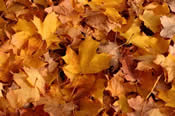| |
| Home |
| Landscaping |
| Irrigation |
| Gallery |
| Seasonal |
| Monthly Tips |
| Our Service Areas |
| Your Privacy |
| Contact Us |
| January |
| February |
| March |
| April |
| May |
| June |
| July |
| August |
| September |
| October |
| November |
| December |
Summer has quickly slipped away again and your landscape will benefit from some late 
season care and winter preparations.
Check new plants for watering every 10-14 days until the ground freezes, unless there is 1" of rain.
Prune out only deadwood on plants.
Be mindful of any fruit which may have fallen and continue to fall. If left unchecked, they will decompose, attract various insects and eventually choke out the lawn leaving brown or bare spots.
Rake up and remove fruit and leaves from all lawn areas regularly where insect and disease problems will quickly occur. If you have a compost pile turn with every addition to aid in decomposition. If you do not have a compost pile, consider starting one for an endless supply of compost for your yard without the city disposal charges. While it is not recommended that fruit be included in your personal compost pile due to insect infestations (it rarely gets hot enough to kill any possible infestation), if turned often enough (once a week) the insects will be kept at bay). Contact Back 2 Green to schedule fall cleanup services.
 Protect the trunks of young trees from rodents with temporary plastic tree spirals to be removed in the spring.
Protect the trunks of young trees from rodents with temporary plastic tree spirals to be removed in the spring.
Although deciduous shrubs and shade trees can be planted up until the ground freezes, we prefer mid- October to be our cutoff date for evergreen planting. The goal is to allow enough time for evergreens to root out into the existing soil before winter arrives. Weather doesn't follow calendar dates - it may happen suddenly and Back 2 Green favors erroring on the side of caution.
Fall is the perfect time to incorporate soil amendments in planting beds. Top-dressing with organic matter can be done after autumn clean up.
Rake, chop and compost fallen leaves from your lawn.
Deer are an increasing problem in some of our Northwest landscapes. A method, which has been found to be successful is the use of black plastic netting, the type used to protect blueberries or cherries from birds. Cover susceptible evergreen plants, such as yew, arborvitae or rhododendrons making sure to secure the edges of netting to the ground and to the plant itself. Also rutting deer often damage the trunks of young trees by rubbing the velvet from their antlers on them. Protect new trees up to 3" diameter from deer with either 4" diameter corrugated drain tile (split on one side), or plastic-spiral tree protectors in early October. Both must be removed in spring.
Have you planted your bulbs yet? Plant spring bulbs now Once again bulbs can be planted up until the ground freezes, we prefer mid-October to be our cutoff date for bulb planting as well. The goal is to allow enough time for bulbs to root out into the existing soil before winter arrives. Remember, weather doesn't follow calendar dates. The general rule is to plant twice the depth of the bulb in the soil. Bulbs should be slightly deeper on sandy soils. Make sure to plant the root end down. If you have high rabbit or squirrel populations, consider using more daffodils than tulips or crocus as they are poisonous and will not be eaten off or dug up. Extend your perennial interest by planting clumps of bulbs between late spring, summer or fall blooming perennials.
This is one of the best times apply a slow release fertilizer to your woody plants. If done now, it will not stimulate new growth until next spring. One less thing to do!
For your lawn, consider applying your final fertilizer for the year to winterize at the end of October. Fall fertilization gives turf grass the strength it needs to withstand cold and wet Washington winters. In spring, it results in a greener, thicker lawn with greater ability to choke out weeds and deny bare spots for crabgrass to germinate.
Examine your yard for fall interest. If you find it lacking, consider planting common witch hazel whose spider-like yellow flowers are seen now. Many ornamental grasses shine now, along with Autumn Joy sedum, Snowbank, asters, and sweet autumn clematis. Stop in at your local nursery for a wide selection of fall interest plants or call Back 2 Green for a consultation.